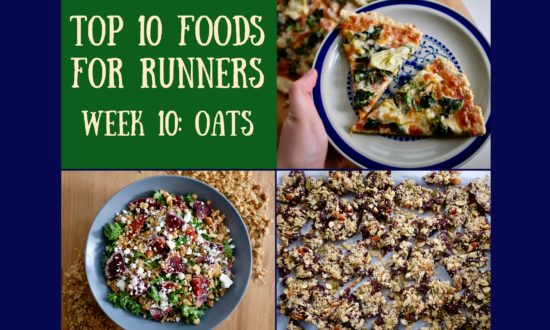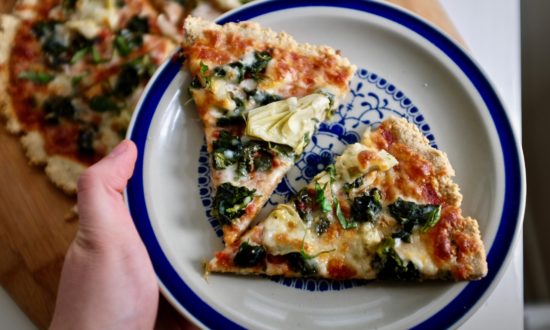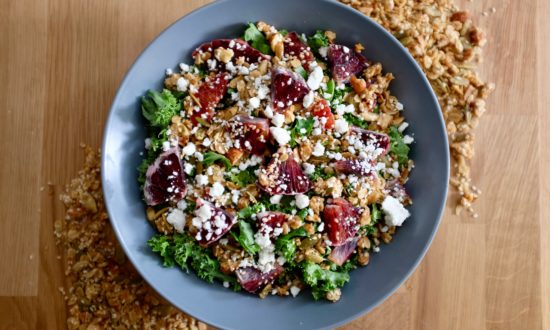Three cheers for week four of the Top 10 Foods for Runners series!! This week… Dark leafy greens! As in the stuff that used to aspire to not much more than a garnish on the dinner plate.
Nowadays, people love their dark leafy greens. Or at least they pretend to. I’ll be the first to admit that even though I know some of these greens would more or less give me superpowers, I can’t bring myself to eat them. Like arugula. That stuff is not at all tasty and I’ll fight anyone who says otherwise. Not really. If you are an arugula fan, good for you and I’m super jealous.
I’ve told my brother every time I serve him something with kale (followed by his protests) that kale is an acquired taste. Eventually, you may just start to like it. That’s what worked for me, anyway. He has yet to experience the results of this theory.
The upside of dark leafy greens is even though they might not always be the tastiest, they are very easy to sneak into things. You don’t have to make greens the star of the show if you’re not the biggest fan. Add spinach to your smoothie, a few handfuls of kale to your pasta, a few extra greens on your sandwich. Honestly, you probably won’t even notice them (unless you make a big deal out of it. Don’t be that guy).
If you can swing it, always go with organic greens. If not, nonorganic greens are still better than no greens at all. The nice part about adding more dark leafy greens to your diet is you get to do some experimenting. There are so many to choose from! Give a few a try and see which you can tolerate- I mean enjoy- the most. The darker, the better (meaning more nutrients). So those days of premade iceberg salad mixes are gone, right??
Types of dark leafy greens
- Spinach: The milder-tasting, delicate green. Softer and less bitter than others. Spinach is full of iron and vitamins A, C and K. Spinach is often eaten raw in salads or on sandwiches or steamed/sauteed if you’re Popeye.
- Lettuce: The building block of the classic salad. Just remember, the darker the leaf, the higher the nutrients. Dark romaine leaves can pack in plenty of nutrients. Super mild and on the crunchier side. Typically eaten raw in salads or on sandwiches.
- Kale: This green has really been in the spotlight these past few years. Eaten plain and raw, it can be pretty bitter. Massaging the leaves with salt helps break down that bitterness and makes it much more enjoyable to eat. Kale is also rich in vitamins A, C and K. It is typically enjoyed (massaged) in salads lots of “bowls” and you can even make them into a type of chip (will they taste like potato chips? Nooo. But hey, they’re not half bad)
- Arugula: Arugula is quite bitter. Some fancier people like to call it “peppery,” but they are pretty much just saying it’s super bitter. However, if you’re a fan of all things bitter, you’re in luck. This green is packed with vitamins A and C, and it is a good source of calcium and fiber. Arugula is typically used in salads, to top off pizzas, and on sandwiches.
- Bok Choy: closely related to cabbage and made popular through Chinese cuisine. The less mature bok choy can add crunch to your dishes. the more mature bok choy can be cooked and used in sautees, stir-frys, kimchi, and ramen. Bok choy contains vitamins C, A, and K, calcium, magnesium, potassium, manganese, and iron.
- Chard: Swiss chard, the young leaves, have a similar texture to lettuce. The more mature leaves are a bit more bitter used in sautees and pasta dishes. Swiss chard is very nutritious. Besides being loaded with vitamins A, C, and K, it’s also a good source of potassium and iron.
- Mustard/collard greens: Although mustard greens are a bit more “peppery,” they have the same nutritional value as collard greens. They are rich in vitamins A, C, and K and folate. They are commonly sauteed to reduce their bitterness along with ham, pork, or vegetables.
- Microgreens: Baby greens harvested just a few days after sprouting. They have been tested to have more nutrients than their mature counterparts, like vitamins C, E, K, and beta-carotene, but they have to be used very quickly because they are susceptible to E-coli outbreaks. Microgreens should be eaten raw to top off a dish, cooking them is not recommended.
- Broccoli: Broccoli is part of the cabbage family and closely related to leafy greens. It’s not very bitter and very versatile. You can eat it raw or cooked without looking weird either way. Along with vitamins A, C, and K, broccoli is also full of fiber and folate.
What makes greens great
- Vitamin A: An essential vitamin! An essential vitamin = necessary for the body to function. Helps form and maintain healthy skin, bones, soft tissue, and mucus membranes (you’d think they would be able to come up with a less gross name for that).
- Vitamin C: Another essential vitamin! Promotes healthy teeth and gums. Helps the body absorb iron (as you’ll see below) and maintain healthy tissue. It also promotes wound healing!
- Vitamin K: Not an essential vitamin, but still pretty darn important. Without it, your blood wouldn’t coagulate (stick together). Some studies have also show that it is important to bone health.
- Iron: Runners are notorious for being low in iron, especially us females! While a standard serving of dark leafy greens provides 10-15% of your daily iron, sometimes your body can’t absorb it well. There’s a lot of science behind this, but for some greens, like spinach, you’ll have to unlock the iron by pairing it with acidic foods like tomatoes or citrus. Magically, that pairing helps aide in iron digestion.
- Fiber: Most greens have between 2 and 5 grams of fiber per serving. They have a good mix of soluble fiber (helps lower cholesterol) and insoluble fiber (aids in digestion).
- Beta-carotene: Along with lutein, lycopene, and zeaxanthin. These antioxidant carotenes ward off several age-related diseases like sight loss.
- Folic Acid: A serving of dark leafy greens typically contains 10-25% of your daily folic acid needs (an essential vitamin!). Folic acid got its fame for fighting against birth defects, but it also helps to ward off heart disease.
- Magnesium: When you’re low in magnesium, your heart has to work harder when exercising. This can cause greater physiological stress, and who wants that?
- Calcium: A serving of dark leafy greens contains about 10-20% of your daily calcium. This can be lost through boiling, so make sure to steam or microwave the greens instead.
- Potassium: Dark leafy greens also include 5-10% of your daily potassium needs per serving. Same as the calcium, the greens’ potassium can be lost during the boiling process.
*For best results, try to eat a variety of greens in your diet to get the fullest range of nutrients possible.
Tips for buying/storing dark leafy greens
- You’ll want to avoid wilted greens as well as those with browned edges. Those are sure signs of old age and/or dehydration. Look for crisp, firm, and colorful.
- You’ll want to keep excess water off greens while storing them. Greens usually have about 5 days before wilting. I like to slip a paper towel or two in the bag with the greens. It seems to keep them fresh for longer.
- Rinse off dirt and gross pesticides with cold water. make sure you remove all the excess water you can.
- When chopping up greens to use for cooking, keep the pieces larger than bite size if you can to keep the nutrient loss to a minimum.
- To massage kale: Remove the leafy part from the stalks. Tear leafy part into bite-sized pieces and add them to a bowl. Sprinkle with salt and gently incorporate with your hands, rubbing the leaf pieces until the kale is bright green. Perfect for salads.
- For the more tender greens like romaine and spinach, use hands instead of salad tongs to mix. No matter how gentle you are, salad utensils always bruise the greens.
Recipes
So I used my two or three favorite dark leafy greens in these recipes (technically, basil is a dark leafy green. Yesss), but feel free to mix and match with your favorites!

Green monster pasta
Ingredients
For the pesto
- 1/4 cup almonds, toasted
- 2 cloves garlic
- 1/3 cup parmesan cheese
- 1 cup basil, packed
- 1 cup kale, stems removed, packed
- 1 cup spinach, packed
- 1/4 cup olive oil
For the pasta
- 12 oz baby broccoli (broccoli), long stems removed and sliced thin
- 1/2 tbsp olive oil
- 1 box whole grain pasta
- 1 cup fresh/frozen peas
- 3/4 cup ciliegine (or fresh mozzarella), chopped
- salt and pepper
Instructions
For the pesto
-
In a food processor, combine almonds, garlic, and parmesan. Pulse until combined.
-
Add basil and pulse until combined. Repeat with kale and spinach. Add olive oil and pulse until smooth. Season with salt and pepper.
For the pasta
-
Preheat oven to 375.
-
Toss broccolini with olive oil and bake for 15 minutes. Season with salt and pepper.
-
Meanwhile, cook the pasta according to package instructions. Drain pasta, reserving 1/4 cup pasta water, and return pasta to pot.
-
Add peas and broccolini. Add pesto and pasta water if needed. Stir in ciliegine (mozzarella) until it begins to melt. Season with salt and pepper.

Gruyere and greens bake
Ingredients
- 10 oz mushrooms, diced
- 2 tsp olive oil, divided
- 2 cloves garlic, minced
- 1/4 tsp rosemary, minced
- 3 cups kale, stems removed, chopped
- 2.5 cups spinach, chopped
- 4 cups cooked farro
- 1.5 cups shredded gruyere and/or swiss cheese, divided
- 1 cup panko
- 1 tsp fresh parsley (optional)
- salt and pepper
Instructions
-
Preheat oven to 450 degrees.
-
Heat 1 tsp olive oil in a large skillet over medium heat. Add garlic, mushrooms, and rosemary. Cook until mushrooms are golden and no liquid remains in the pan.
-
Turn heat to low and add greens. Cook until greens are wilted and bright green.
-
In a medium bowl, combine farro, greens/mushrooms, 1 cup gruyere, and salt and pepper.
-
Lightly oil a 9x9 baking dish. Evenly distribute farro mixture in baking dish.
-
In a bowl, combine panko, 1 tsp olive oil, and 1/2 cup gruyere. Top farro with panko mixture.
-
Bake for 15 minutes or until the panko is golden brown. Top with parsley and serve hot.

Protein-packed salad
Ingredients
- 2 cups baby potatoes, quartered
- 2 tsp olive oil, plus more for frying
- 1/2 tsp rosemary, minced
- 8 raw chicken tenders
- 1.5 cups pretzels
- 2 eggs, beaten
- 1/4 cup flour
- salt and pepper
- 10-12 cups kale, stems removed and torn into bite-sized pieces
- 1 avocado, diced
- 1 cup grape tomatoes, halved
- 3/4 cup shredded cheddar cheese
- 4-6 eggs, hard-boiled, peeled, and chopped
- honey mustard dressing (I used Annie's Naturals Lite Dressing Honey Mustard Vinaigrette)
Instructions
-
Preheat oven to 425 degrees.
-
Toss potatoes in 2 tsp olive oil and rosemary. Bake, stirring once, for 35 minutes or until golden. Season with salt and pepper
-
Meanwhile, pulse pretzels in food processor until they have a fine crumb texture. Transfer to a wide, shallow dish.
-
Coat each chicken tender with flour (shaking off excess), egg, and pretzel crumbs.
-
Cover a heavy-bottom pan with olive oil. Once oil is hot (medium heat), add chicken. Cook on each side until golden and crisp. With a meat thermometer, check the doneness of the tenders before removing them from the heat. Repeat with all tenders.
-
Add kale to a large bowl. Add a few sprinkles of salt and massage salt into kale leaves with your hands.
-
Top with avocado, tomatoes, potatoes, sliced chicken, cheese, and eggs. Add dressing and mix together. Divide between four bowls and enjoy!
Sources
- https://www.livestrong.com/article/358248-list-of-dark-green-leafy-vegetables/
- https://www.drweil.com/diet-nutrition/nutrition/what-are-microgreens/
- http://foodfacts.mercola.com/bok-choy.html
- https://www.runnersworld.com/nutrition/vegetable-tips-for-runners
- https://medlineplus.gov/ency/article/002399.htm







